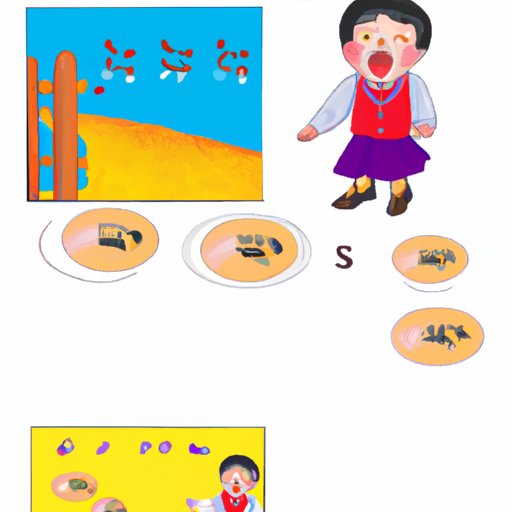Introduction
Writing is an important skill for children to learn, and teaching it to kindergarteners can be a challenging but rewarding task. This article aims to provide simple yet effective strategies and ideas to help teachers successfully teach writing to kindergarteners. It will cover topics such as using songs and nursery rhymes, providing hands-on activities, incorporating games and activities, introducing pre-writing activities, and making use of visual aids.

Use Songs and Nursery Rhymes to Introduce Basic Concepts of Writing
Using songs and nursery rhymes is an excellent way to introduce basic concepts of writing to kindergarteners. Not only are they fun and engaging, but they can also help children learn the alphabet, spelling, letter formation, and more. Additionally, songs and nursery rhymes can help reinforce these concepts in an enjoyable way.
The benefits of using songs and nursery rhymes to teach writing to kindergarteners include:
- They are fun and engaging.
- They help children learn the alphabet, spelling, letter formation, and more.
- They can help reinforce concepts in an enjoyable way.
- They can help improve memory and recall.
Some examples of songs and nursery rhymes that can be used to teach writing to kindergarteners include:
- “The Alphabet Song”
- “Bingo”
- “Wheels on the Bus”
- “Old MacDonald Had a Farm”
- “Twinkle Twinkle Little Star”
Provide Hands-on Activities that Allow Children to Explore Different Writing Tools
Hands-on activities are a great way for kindergarteners to explore different writing tools. These activities allow them to practice writing with pencils, pens, markers, crayons, and other materials. They can also help children develop their fine motor skills and improve their handwriting.
Materials needed for hands-on activities include:
- Pencils
- Pens
- Markers
- Crayons
- Paper
- Whiteboards
- Colored paper
- Stickers
Examples of hands-on activities that can be used to teach writing to kindergarteners include:
- Tracing letters.
- Drawing shapes and patterns.
- Making words with magnetic letters.
- Writing stories or poems.
- Making cards for friends and family.
- Creating artwork with colored paper and stickers.
Incorporate Games and Activities to Make Learning Fun
Incorporating games and activities into writing lessons is a great way to make learning fun for kindergarteners. Games and activities can help children learn the alphabet, spelling, letter formation, and more in an enjoyable way. Additionally, they can help children develop their fine motor skills and improve their handwriting.
The benefits of incorporating games and activities into writing lessons include:
- They are fun and engaging.
- They help children learn the alphabet, spelling, letter formation, and more.
- They can help improve memory and recall.
- They can help develop fine motor skills and improve handwriting.
Examples of games and activities that can be used to teach writing to kindergarteners include:
- Letter matching games.
- Spelling bee competitions.
- Word searches.
- Crossword puzzles.
- Scavenger hunts.
- Storytelling.
Introduce Pre-writing Activities
Pre-writing activities are a great way to help kindergarteners prepare for writing. These activities can help children develop their fine motor skills and sharpen their pencil grip. Additionally, they can help children become familiar with the shapes and lines of letters so they can write them correctly.
Types of pre-writing activities that can be used to teach writing to kindergarteners include:
- Tracing lines and shapes.
- Doing finger tracing exercises.
- Playing with play dough.
- Drawing in sand or rice trays.
- Molding clay.
The benefits of pre-writing activities include:
- They help children develop their fine motor skills.
- They help children sharpen their pencil grip.
- They help children become familiar with the shapes and lines of letters.
- They can help children write letters correctly.

Make Use of Visual Aids
Visual aids are a great way to help kindergarteners learn how to write. They can provide children with a visual representation of the alphabet, spelling, letter formation, and more. Additionally, they can help children understand concepts more easily and can help improve memory and recall.
Types of visual aids that can be used to teach writing to kindergarteners include:
- Alphabet charts.
- Posters.
- Flashcards.
- Books.
- Videos.
- Computer programs.
The benefits of using visual aids include:
- They provide a visual representation of the alphabet, spelling, letter formation, and more.
- They can help children understand concepts more easily.
- They can help improve memory and recall.
- They can help reinforce concepts in an enjoyable way.
Conclusion
Teaching writing to kindergarteners can be a challenging but rewarding task. This article has provided simple yet effective strategies and ideas to help teachers successfully teach writing to kindergarteners. The topics discussed include using songs and nursery rhymes, providing hands-on activities, incorporating games and activities, introducing pre-writing activities, and making use of visual aids.
By utilizing these strategies and ideas, teachers can create a fun and engaging environment for learning. With patience and dedication, teachers can help kindergarteners develop the skills necessary to become successful writers.
(Note: Is this article not meeting your expectations? Do you have knowledge or insights to share? Unlock new opportunities and expand your reach by joining our authors team. Click Registration to join us and share your expertise with our readers.)
